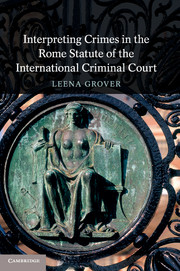Book contents
- Frontmatter
- Dedication
- Contents
- Foreword
- Acknowledgements
- 1 Introduction
- 2 The state of the art
- 3 Guiding interpretive principle
- 4 Challenges to the principle of legality
- 5 Operationalizing the principle of legality
- 6 Custom as an aid to interpretation
- 7 Internal indicia of codification
- 8 External indicia of codification
- 9 The Vienna Convention (1969) and aids to interpretation
- 10 Conclusions
- Bibliography
- Index
- References
7 - Internal indicia of codification
Published online by Cambridge University Press: 05 November 2014
- Frontmatter
- Dedication
- Contents
- Foreword
- Acknowledgements
- 1 Introduction
- 2 The state of the art
- 3 Guiding interpretive principle
- 4 Challenges to the principle of legality
- 5 Operationalizing the principle of legality
- 6 Custom as an aid to interpretation
- 7 Internal indicia of codification
- 8 External indicia of codification
- 9 The Vienna Convention (1969) and aids to interpretation
- 10 Conclusions
- Bibliography
- Index
- References
Summary
Introduction
In Chapter 6, an attempt was made to explain why, in order to develop a method of interpretation for crimes in the Rome Statute, the relationship between the Statute and custom must be understood. The nature of this relationship is essential to determining custom’s role as an aid to interpretation and the relationship of this aid to other interpretive aids, especially the Elements of Crimes. The codification study that follows is guided by indicia of codification identified in the previous Chapter. The goal in this and the following Chapter is to determine whether the definitions of crimes in the Rome Statute are more of a codification of custom or a progressive development of international criminal law. Codification experts disagree on the relative weight to be given to indicia of codification in the text of a treaty and those external to it (e.g., travaux préparatoires). Accordingly, all indicia will be considered. In this Chapter, consideration will be given to the provisions of the Rome Statute on the following issues and the clues they offer about the relationship between the Statute and custom: material, personal and temporal jurisdiction; legality; applicable law; the Rome Statute’s relationship to existing and developing international law; definitions of crimes; Elements of Crimes; and mental elements of crimes. In the next Chapter, indicia of codification external to the Rome Statute will be examined.
Material jurisdiction (article 5)
According to the preamble of the Rome Statute, crimes within its jurisdiction are ‘grave’ and ‘threaten the peace, security and well-being of the world’. They are the ‘most serious crimes of concern to the international community as a whole’ and ‘must not go unpunished’. This notion of seriousness is expressly reiterated in articles 1 and 5 of the Rome Statute and in the Elements of Crimes. Article 8(1) of the Rome Statute also emphasizes to the Court and prosecutor that their focus should be on the most egregious war crimes: ‘The Court shall have jurisdiction in respect of war crimes in particular when committed as part of a plan or policy or as part of a large-scale commission of such crimes.’ What does this general gravity threshold suggest about the nature of the crimes within the Court’s jurisdiction?
- Type
- Chapter
- Information
- Publisher: Cambridge University PressPrint publication year: 2014

